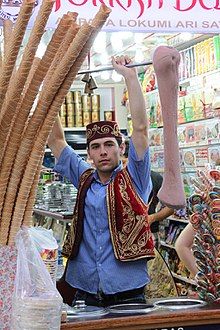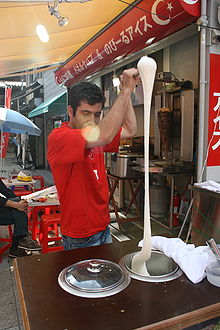Dondurma
 A vendor holds a large mass of salepli dondurma. Note the long-handled paddle and the barrel. | |
| Type | Ice cream |
|---|---|
| Place of origin | Turkey |
| Region or state | Kahramanmaraş |
| Main ingredients | Cream, Whipped cream, salep, mastic, sugar |

Dondurma (in Turkish: Maraş dondurması, meaning "the ice cream of the city of Maraş", also called Dövme dondurma, meaning "battered ice cream") is a Turkish mastic ice cream. It is similar to the Syrian dessert booza.
Dondurma typically includes the ingredients cream, whipped cream, salep, mastic, and sugar. It is believed to originate from the city and region of Maraş and hence also known as Maraş ice cream.[1]
Description
Two qualities distinguish Turkish ice cream: hard texture and resistance to melting, brought about by inclusion of the thickening agents salep, a flour made from the root of the early purple orchid, and mastic, a resin that imparts chewiness.[citation needed]
The Kahramanmaraş region is known for maraş dondurması, a variety which contains distinctly more salep than usual. Tough and sticky, it is sometimes eaten with a knife and fork.[citation needed]
Consumption and culture

Dondurma is commonly sold from both street vendors' carts and store fronts, where the mixture is churned regularly with long-handled paddles to keep it workable. Vendors often tease the customer by serving the ice cream cone on a stick, and then taking away the dondurma with the stick by rotating it around, before finally giving it to the customer. This sometimes results in misunderstandings among customers unfamiliar with the practice. Vendors often wear traditional clothing of the Ottoman period.[citation needed]
In some places in Turkey it is customary to treat the ice cream as a Shawarma and cut it with a butcher knife.[citation needed]
As of 2010, the average rate of consumption in Turkey was 2.8 liters of ice cream per person per year (compared to the United States at 18.3 liters per person in 2007, and world consumption leader New Zealand at 22–23 liters in 2006).[2][3]
Some Turks believe that cold foods, such as ice cream, will cause illnesses – such as sore throats and the common cold; it is held that consumption of warm liquid while consuming ice cream will counteract these effects.[citation needed]
The popularity of salepli dondurma has caused a decline of wild orchids in the region and led to a ban on exports of salep.[4]
Dondurma is also consumed in Greece, especially in the north of the country, where it is called "dudurmas" or "kaimaki".[citation needed]
See also
Notes and references
- ^ Naver Kowledgeins, "Turkey Ice-cream". Naver. 2004, February 8th. 24 April 2008
- ^ "Hürriyet Daily News". Hürriyet Daily News.
- ^ "The Dairy Education eBook Series - Food Science". www.foodsci.uoguelph.ca.
- ^ "Ice cream threatens Turkey's flowers". BBC News. 5 August 2003. Retrieved 1 May 2010.
